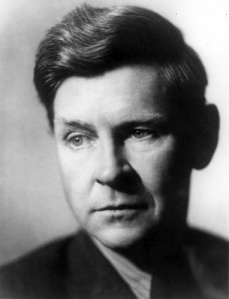Olaf Stapledon facts for kids
Quick facts for kids
Olaf Stapledon
|
|
|---|---|
 |
|
| Born | 10 May 1886 Seacombe, Wallasey, Cheshire, England, UK |
| Died | 6 September 1950 (aged 64) Caldy, Cheshire, England, United Kingdom |
| Occupation | Novelist, philosopher |
| Genre | Science fiction, philosophy |
| Notable works | Star Maker, Last and First Men, Odd John |
William Olaf Stapledon (born May 10, 1886 – died September 6, 1950) was a British thinker and writer. He wrote many important science fiction books. His stories often explored big ideas about the future of humanity and the universe.
Contents
Life Story of Olaf Stapledon
Olaf Stapledon was born in Seacombe, Wallasey, a town near Liverpool, England. He was the only child of William Clibbert Stapledon and Emmeline Miller. For the first six years of his life, he lived with his parents in Port Said, Egypt.
He went to Abbotsholme School and then to Balliol College, Oxford University. There, he studied history and earned his first degree in 1909. After a short time teaching, he worked in shipping offices from 1910 to 1913.
During World War I, Olaf helped people as part of the Friends' Ambulance Unit. He worked in France and Belgium from 1915 to 1919. On July 16, 1919, he married Agnes Zena Miller. She was his cousin from Australia, and they had been writing to each other during the war.
Olaf and Agnes had two children: a daughter named Mary (born 1920) and a son named John (born 1923). In 1920, they moved to West Kirby. In 1925, Olaf earned a special degree called a PhD in philosophy from the University of Liverpool. He wrote a book about ethics, which is the study of right and wrong.
Soon, he started writing fiction to share his ideas with more people. His book Last and First Men was very popular. This success made him decide to become a full-time writer. He wrote many more books about ideas that are now called Transhumanism. This is about how humans might evolve or change in the future.
In 1940, his family built a new home in Caldy and moved there. After 1945, Olaf traveled a lot to give talks. He visited countries like the Netherlands, Sweden, and France. In 1948, he spoke at a peace conference in Wrocław, Poland. He also went to a peace conference in New York in 1949.
In 1950, he joined the movement against apartheid, which was a system of unfair racial separation in South Africa. After giving talks in Paris, he returned home to Caldy. He sadly died very suddenly from a heart attack.
Olaf Stapledon was cremated, and his family scattered his ashes. They chose a spot on the sandy cliffs overlooking the Dee Estuary. This was one of Olaf's favorite places and appeared in some of his books.
His Amazing Works
Olaf Stapledon's books had a big impact on many famous writers. These include Arthur C. Clarke, Brian Aldiss, and C.S. Lewis. He came up with many new ideas that are now common in science fiction. He got many of these ideas from his studies in philosophy.
New Ideas in Science Fiction
Even before the word "transhuman" was used, Olaf wrote about humans changing and evolving. He also wrote about a "supermind," which is like many minds joining together.
His book Star Maker was the first to describe something called Dyson spheres. These are giant structures that could be built around stars to capture their energy. The scientist Freeman Dyson said this book gave him the idea.
Last and First Men also described early ideas of genetic engineering. This is about changing living things at a basic level. It also talked about terraforming, which means changing a planet to make it suitable for human life.
In his novel Sirius, he wrote about a dog whose intelligence was made as high as a human's.
Olaf's stories often show smart beings trying to achieve great things. But they often face a universe that doesn't care, or people who don't understand their big dreams.
Besides writing fiction, Olaf Stapledon also taught at the University of Liverpool. He taught English literature, industrial history, and psychology. He wrote many non-fiction books about politics and ethics. In these books, he talked about the importance of "spiritual values." He meant values that help people understand themselves better and feel connected to a larger community.
Fiction Books
- Last and First Men: A Story of the Near and Far Future (1930)
- Last Men in London (1932)
- Odd John: A Story Between Jest and Earnest (1935)
- Star Maker (1937)
- Darkness and the Light (1942)
- Old Man in New World (short story, 1944)
- Sirius: A Fantasy of Love and Discord (1944)
- Death into Life (1946)
- The Flames: A Fantasy (1947)
- A Man Divided (1950)
- Four Encounters (1976)
- Nebula Maker (drafts of Star Maker, 1976)
Non-fiction Books
- A Modern Theory of Ethics: A study of the Relations of Ethics and Psychology (1929)
- Waking World (1934)
- Saints and Revolutionaries (1939)
- New Hope for Britain (1939)
- Philosophy and Living, 2 volumes (1939)
- Beyond the "Isms" (1942)
- Seven Pillars of Peace (1944)
- Youth and Tomorrow (1946)
- The Opening of the Eyes (edited by Agnes Z. Stapledon, 1954)
Poetry Books
- Latter-Day Psalms (1914)
See also
 In Spanish: Olaf Stapledon para niños
In Spanish: Olaf Stapledon para niños

